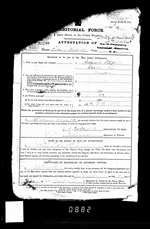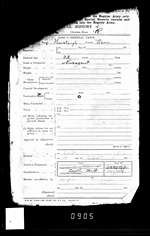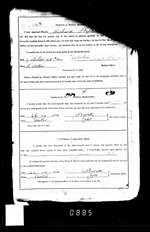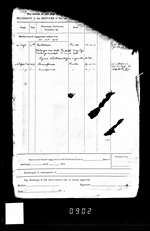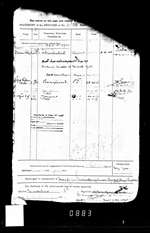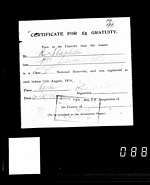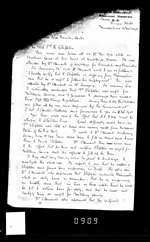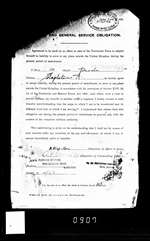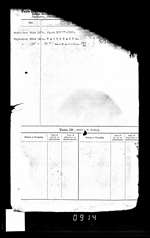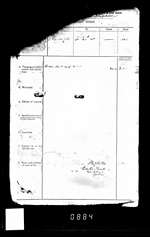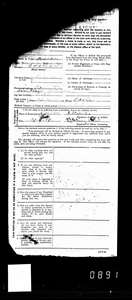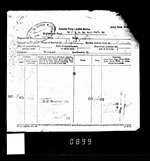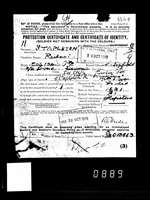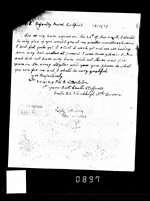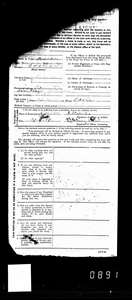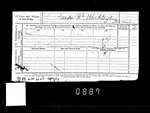
|
| HOME PAGE |
| MEMORIAL CROSS |
| HISTORY of the CROSS |
| ROLL of HONOUR |
| LINKS |
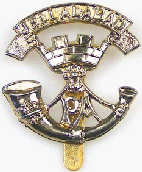 Richard Stapleton Richard StapletonPrivate 111, 3106, 30088, 203198, 204124 Royal Defence Force 1st (Garrison) Battalion South Staffordshire Regiment The name Stapleton is a familiar one in Devon and of course includes a large number of families. The family tree of Richard Stapleton is attached to this page. Richard was the uncle of Albert Stapleton (just 10 years younger than Richard), who, having enlisted in the 6th Devons in 1914, died at home within the first few weeks of his service and is buried in the Winkleigh churchyard. Two brothers of Albert, Alfred and Charles, also served in the war, but their documents have not survived. Albert’s story is recorded among the names on the Memorial Roll, while Alfred and Charles were included on the Roll of Honour. Richard was born in 1881, the youngest of 6 children of Peter Stapleton and his wife Emily, living in 1901 in Bulleid’s Hill (now Cooper’s Hill). Peter, 57, is described in the census as a road contractor, while his son Richard aged 19 was an agricultural labourer. By 1911, Peter was himself working as an agricultural labourer, living in a cottage on the Exeter Road, while Richard now aged 29 and still at home, is described as a news agent and bill poster. The surviving records are referred to in the text by number, such as Document 1A; clicking on these numbers displays an image of that document. Alternatively, all the documents can be seen on one page by clicking the Army Records thumbnail on the right. Richard Stapleton was 32 when war broke out. Relatively older than the younger men in the village some of whom were seeking to join or go overseas with the 4th, 5th or 6th Battalions of the Devon Territorials, or alternatively join the Regular Army or the Devon Kitchener battalions (8th and 9th Devons), Richard decided instead to enlist in the National Reserve. He had served already before the war in the 4th Devons and was therefore qualified to join the 3rd Battalion (Special Reserve), enlisting on 26th October 1914. (Document 1A, Document 1B, Document 1C). His army number was 111. At the time of Richard’s enlistment, the Special Reserve had been split up into ‘Protection Companies’, to form guard duties all over the South-Western counties in anticipation of a possible German invasion. However, in March 1915 these Protection Companies were re-designated as ‘Supernumerary Companies TF’, and it was decided that a trawl should be conducted to extract all men capable of marching 10 miles with a rifle and 150 rounds of ammunition. Those categorized as Category A went to service battalions, Category B men were sent to Rifle Brigade battalions while the C men went to Provisional battalions posted to Egypt and India to replace the Territorials who were by now themselves committed to Gallipoli or Mesopotamia. The rump that was left was formed into the Royal Defence Corps. Just before this re-organisation, Richard had already felt that his guard duties were affecting his health and he had obtained a discharge on medical grounds on 3rd February 1915. (Document 2A, Document 2B). However, this was not to be for long; as a result of further investigations the discharge was cancelled (Document 4)Document 4) on 12th March 1915 and on 29th April 1916 Richard was transferred to the 101 Company of the Royal Defence Corps, the reserve battalion of the South Staffordshire Regiment. The transfer documents included a blank ‘Crime Sheet’. Richard’s conduct was beyond reproach. (Document 5). He then continued to serve at ‘home’ until 3rd November 1916. Richard was now classified as part of the ‘National Resreve’, Class 2. This class was for men under the age of 50, who could satisfy the medical requirements to join a combatant unit for home defence or for duty in fixed positions or administrative work at home. Richard received a gratuity of £5 on mobilization; the document is dated 8th January 1915. (Document 3) Richard now agreed to sign the Overseas and General Service Obligation on 10th June 1916 (Document 6); he was now liable as a Class II reservist to be treated as any other Territorial or Regular Army soldier. On 20th September 1916 Richard was posted to the 3rd/4th Battalion of the South Staffordshire Regiment, and on the same day to the 2nd/4th where he received both inoculation and vaccination (Document 7). These were Reserve battalions. The 3rd (Reserve) Battalion had formed in August 1914, in Whittington, Litchfield. A depot/training unit, it remained in UK throughout the war. Richard moved again in November 1916 to Forest Hall (Newcastle) for duty with the Tyne Garrison. (Document 8). On 20th May 1917 he was posted into the General Reserve battalion of the South Staffordshires, named the 1st (Garrison) Battalion. His number was now 204124. It was formed at Lichfield in January 1917 and as we know from a letter written much later by Richard on 19th November 1919, moved immediately to India. Richard was posted into ‘B’ Company of the battalion. He was not to return again to England until after the war was over. There is now a large gap in the documents from May 1917 until his return from India. Sadly, too, the War Diary of this battalion has also not survived, so we have no knowledge of where he was stationed, or what particular work the battalion undertook. A British military presence in India, no matter how poorly trained or inactive were the troops, was essential at a time when the first stirrings of an Indian independence movement were already apparent. With the end of the war, the regular army could once again take over the policing of India, and once these changes had been put into effect Richard embarked for home and demobilisation. On 19th September 1919, a medical examination showed his classification remained A1, age last birthday 38. (Document 9). On 9th October 1919, he shipped back to England on the H.T.Brandenberg (Document 10). On arrival in the U.K. Richard was posted to the 9th Battalion of the South Staffordshire Regiment, a holding unit for men awaiting their turn for the demobilisation process. On arrival at Lichfield Richard was issued with a Protection Certificate (Document 11) on 30th October (a guarantee against possible arrest as a deserter), and granted a month’s leave. A letter survives dated 17th November 1919 (Document 12) in which he requested an extension of leave (expired on 26th) on the grounds that ’I don’t feel quite fit’ and that the weather was very bad. No doubt the climate in Winkleigh must have come as a shock after 3 years in India. The letter is overwritten ‘Not granted’. The letter is itself important, confirming his service in India and an absence of leave during his three years there. At the time of his demobilisation the army record of his marriage and birth of his daughter Emily Lisabella are retained in his documents. (Document 13, Document 14). While some would claim that Richard Stapleton had a relatively easy and safe war, Winkleigh can be proud of the service he gave, luckily revealed to us in those of his documents that have survived. Richard was certainly lucky to have had the opportunity to enlist as a Class II Reservist and thus avoid anything like front-line service; if he had waited for call-up under the Military Service Act of 27th January 1916 (which applied to all men under the age of 41) he would certainly have eventually been called up in Class7 (those born in 1881) for more strenuous service once the call-up extended to the married men. Those who qualified for the National Reserve were exempted from the act. We are fortunate that a large number of Richard’s documents that tell this story in more detail have survived in the ‘burnt documents’ series, the majority of this national treasure having being lost in the blitz. In their original state the documents exist in two files, relating to the early and late periods of Richard’s service life. There are many duplicates and some blanks, a few unreadable sheets because of the fire, and a loss of all those relating to his service in India, but enough has survived to give us an interesting and rather rare insight into how the army handled the National Reserve, using these older men to replace younger troops for duties such as guarding key points and replacing troops sent to police the Empire.
31 January 2014 |
|---|
| [Top] | Back to Roll of Honour Page 2 |

Click on an image for a larger picture
|
